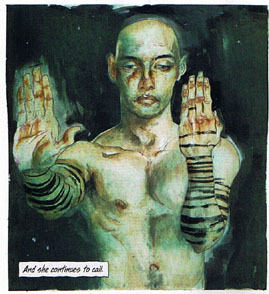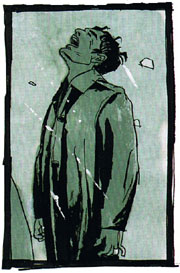
The Fountain is film director, Darren (Pi) Aronofsky’s off-again-on-again pet sci-fi project, due for release early 2006. The trouble with pet projects is they can make the artist’s vision a bit myopic (John Travolta’s sci(entology)-fi turkey, Battlefield Earth, for example). After the studio pulled out of the original, hugely expensive production, Aronofsky had a reality check and went back to his low-budget roots to make a more affordable (though still not cheap) film. Putting his missus, Rachel Weisz (Constantine, The Mummy) in the lead female role opposite Hugh Jackman (X-Men, Van Helsing), must have also helped to get the project up and running again.
Although the original project had been axed, Aronofsky kept the rights to the story and in particular those of the graphic novel. (There seems to be a modern trend of adapting films to graphic novels, although not to same level as the opposite transition.) The final film of The Fountain is different to the original, having been trimmed to meet budgetary demands, whereas the graphic novel is based on the original screenplay. According to Aronofsky, “They have the same parent, the story, yet the siblings are completely unique,” with this printed version being the first-born.
 The story itself covers three time periods as one character searches to beat death and prolong the life of the woman he loves. It is a quest for the Tree of Life and the answer to immortality, with the three stories converging into one truth. The story is paradoxically simple and complex at the same time and is equally suited to both the film and graphic novel media.
The story itself covers three time periods as one character searches to beat death and prolong the life of the woman he loves. It is a quest for the Tree of Life and the answer to immortality, with the three stories converging into one truth. The story is paradoxically simple and complex at the same time and is equally suited to both the film and graphic novel media.
 The book, published in hardback by Vertigo (which is part of DC Comics, which is owned by Warners, who are making the film), is illustrated by Kent Williams, whose previous work has included Blood: A Tale and Havok/Wolverine: Meltdown (further synchronicity with the film’s star now synonymous with the role of Wolverine). The artist’s style is far more painterly than the standard comic/graphic novel fare, but this suits the various phases of the story as it switches between full colour and ink over watercolour wash, with each technique used to evoke both a sense of time and a mood. Anyone expecting to see a more traditional style of illustration usually associated with comics, with its emphasis in clean line work, anatomically precise characters and detailed backgrounds drawn in unusual angles, may be disappointed with this volume. Anyone familiar with David Mack’s work on Kabuki, or even Daredevil, will have no trouble with this approach to sequential art. Page layouts are actually fairly linear, in their use of panels, which is a marked contrast to non-linear nature of the story. It does take a couple of readings to adjust to the time jumps and understand what is happening with the character(s), but it should make the movie that much easier to understand, and if Aronofsky’s previous films are anything to go by this can only be a good thing.
The book, published in hardback by Vertigo (which is part of DC Comics, which is owned by Warners, who are making the film), is illustrated by Kent Williams, whose previous work has included Blood: A Tale and Havok/Wolverine: Meltdown (further synchronicity with the film’s star now synonymous with the role of Wolverine). The artist’s style is far more painterly than the standard comic/graphic novel fare, but this suits the various phases of the story as it switches between full colour and ink over watercolour wash, with each technique used to evoke both a sense of time and a mood. Anyone expecting to see a more traditional style of illustration usually associated with comics, with its emphasis in clean line work, anatomically precise characters and detailed backgrounds drawn in unusual angles, may be disappointed with this volume. Anyone familiar with David Mack’s work on Kabuki, or even Daredevil, will have no trouble with this approach to sequential art. Page layouts are actually fairly linear, in their use of panels, which is a marked contrast to non-linear nature of the story. It does take a couple of readings to adjust to the time jumps and understand what is happening with the character(s), but it should make the movie that much easier to understand, and if Aronofsky’s previous films are anything to go by this can only be a good thing.
For those waiting in anticipation for the release of the film, this serves as a useful interlude, and a chance to get to grips with the story without spoiling the movie’s impact. For those who appreciate a well-illustrated sci-fi story this is worth getting, especially given the paucity of such material. The book is not cheap, at around £30, but it is a large format, quality hard cover publication and is available on import from good comic shops, through Diamond Comic Distribution. Titan Books will be releasing a UK edition in February.
